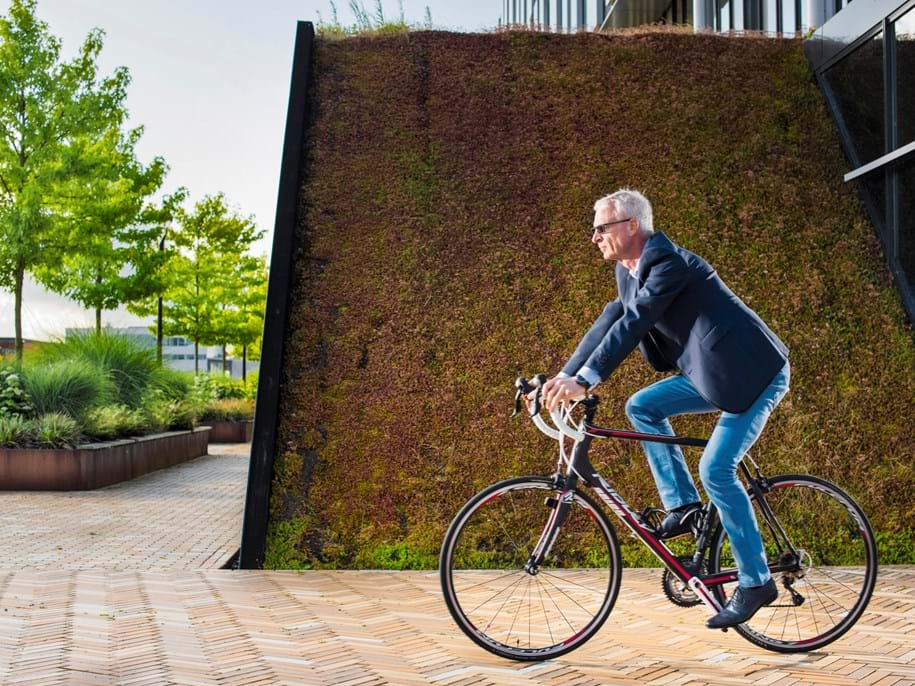
Acoustics are central to the New Way of Working
The 60-year-old senior vice-president of Plantronics Europe and Africa writes extensively about this subject in his book The Smarter Working Manifesto. “The New Way of Working requires a different way of thinking. The old rules do not apply anymore.”
Energetic employees who enjoy doing their jobs. Higher productivity. Improved client satisfaction. Sick days reduced by half. These are results that any manager would love to brag about. At Plantronics, they did it. And it’s thanks to the New Way of Working, which this multinational company integrated into every aspect, literally up to the ceiling.
Whirlwind
Instigator of this new approach is Philip Vanhoutte, a cosmopolitan business executive who feels at home anywhere in the world. His roots can still be detected from his Flemish accent. But Philip Vanhoutte navigates effortlessly in any spot on the globe, whether that be California, London or the Dutch town of Hoofddorp. For more than 35 years, his career has moved like a whirlwind through the world of information and communication technology. The New Way of Working isn’t something he ever had to acquire, he says; he simply never worked any other way.
Working in a flexible way
In the eighties, Philip Vanhoutte started out as an enthusiastic consultant in office automation with Accenture and Wang Labs, and subsequently lived through the laptop revolution in the Dell offices. During all those years, he never sat behind a desktop computer. He took his work along with him, wherever in the world he found himself at that moment. Whether that meant watching the sun rise at the beach in Santa Cruz or sitting in a restaurant in Amsterdam. As global marketing vice-president at Sony Ericsson, he launched, at the beginning of the millennium, the very first smartphone with a Bluetooth connection. His love of technology and flexible working brought him to Plantronics in 2003.
Metamorphosis
Since then, the offices of the multinational all across the globe have experienced a metamorphosis, according to Philip Vanhoutte:
“It used to be that the employee had to adapt to the office building. Now it is the opposite: The office environment has adapted to the wishes and needs of the employee. This is where acoustics take a central role. At Plantronics, it all started in 2010, when the company was forced to reduce three office buildings to one. That was something completely new to us. During that same period, I was invited by Tim Oldman, now CEO of Leesman, to act as a guinea pig for a new diagnostic instrument that was to be created, which would take stock of the complaints and wishes of employees. All 350 employees filled out the digital questionnaires. And you know what we learned? One in three employees would never want to invite their family or friends to visit their place of work. And one in two employees in Germany declared that they were so dissatisfied with the acoustics in their workplace that they could not concentrate on their work. That was an enormous eye-opener.”
A revolutionary approach
The European offices were the first to be worked on. Philip Vanhoutte took a revolutionary approach. First of all, as many walls, doors and corridors as possible were removed, because they only took up space. In addition, he had sound-absorbing ceilings installed, as well as sound-absorbing foam on the walls.
“We divided the space into four acoustic zones, depending on their function: concentration, collaboration, communication and contemplation. That’s right, we even have a space where people can retire for a moment to meditate, listen to music or take a power nap. Conservative managers think that’s a waste of time. That’s nonsense. I’m a sports person. I know that building up energy is crucial in order to perform well. Just exhausting people doesn’t work.”
Acoustic intelligence
Plantronics client contact centres in Europe and the United States were also restyled. Philip Vanhoutte explains: “We implemented all kinds of measures in the area of acoustic intelligence. In a space where many people are talking on the phone at the same time, the presence of a lot of ambient noise is tiring and stressful. So, for instance, we had people work in circles instead of in rows facing each other. That way, the sound of the voices doesn’t reverberate against itself. Nobody works with wired systems either. In our company, we work exclusively with Skype for Business and wireless headsets. Employees make an adult choice as to where they want to work and when. The only conditions are that they get results, save costs as much as possible and respect the surroundings. This is what I call the new freedom.”
Improved health
Philip Vanhoutte’s efforts for this “new freedom” were rewarded. From the UK Contact Centre Association, he received a lifetime achievement award for his revolutionary approach. Now he wants to ensure that architects start paying attention to acoustics right in the construction phase of new office buildings. “This is hardly taken into consideration at present. Most new office buildings already need an acoustic correction as soon as they are completed. That has to change. Soundscaping – a term coined by sound guru Julian Treasure – has to become just as important as landscaping. This leads not only to higher productivity and less fatigue among employees, but also to improved health. I’m convinced of it. The space, the acoustics, the place where you work, and how you work – it is all interconnected. We have now also started a partnership with the Mentally Fit Institute. Their motto is: Manage your energy, not just your time. We want to cherish employees, so that they feel their very best.”
Text: Aliëtte Jonkers
Photographs: De Beeldredaktiem and Michael van Oosten
